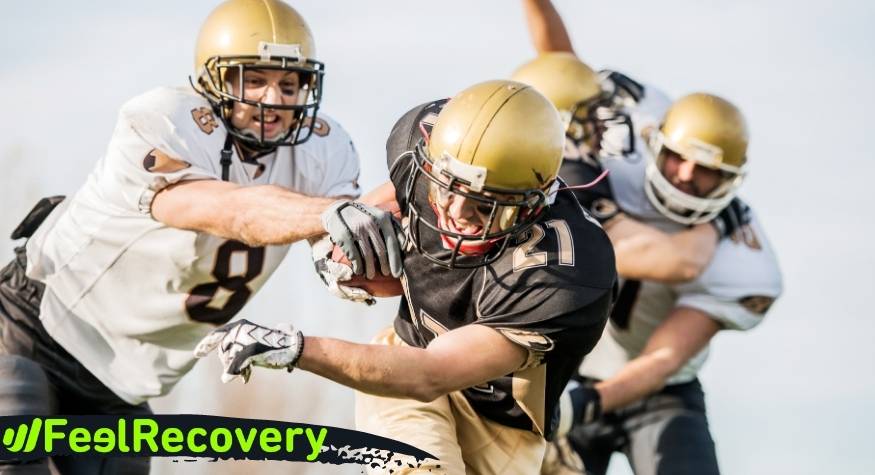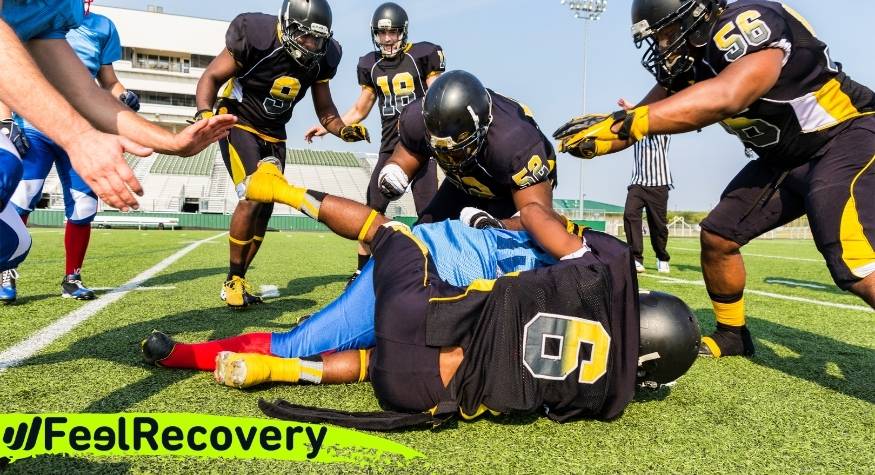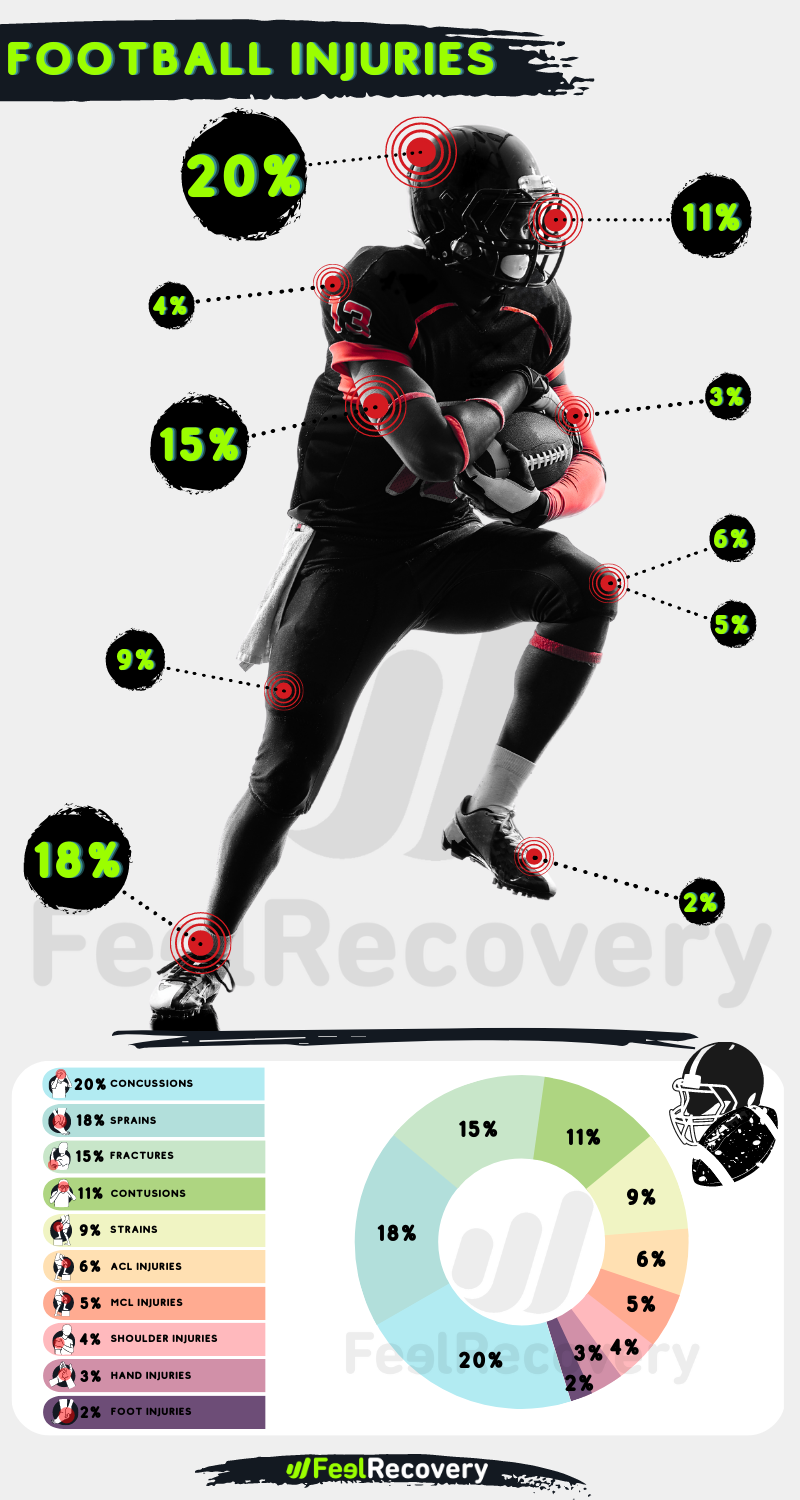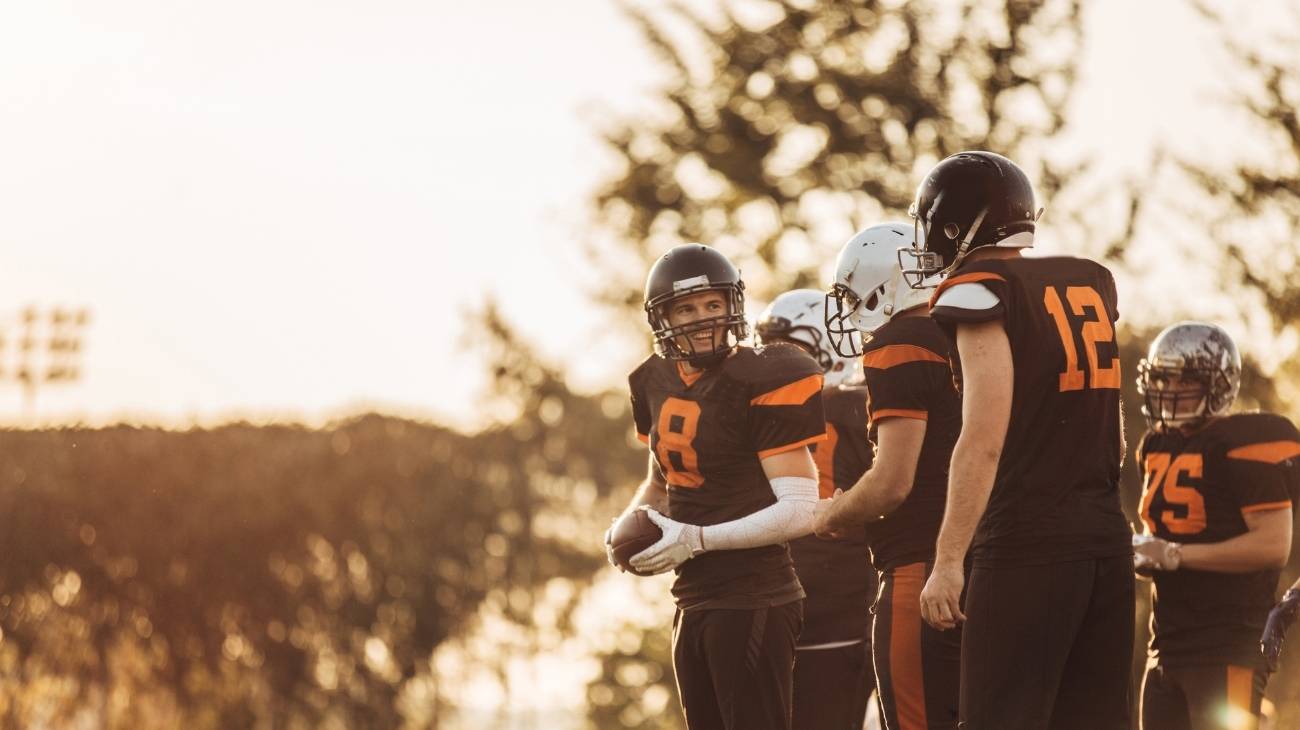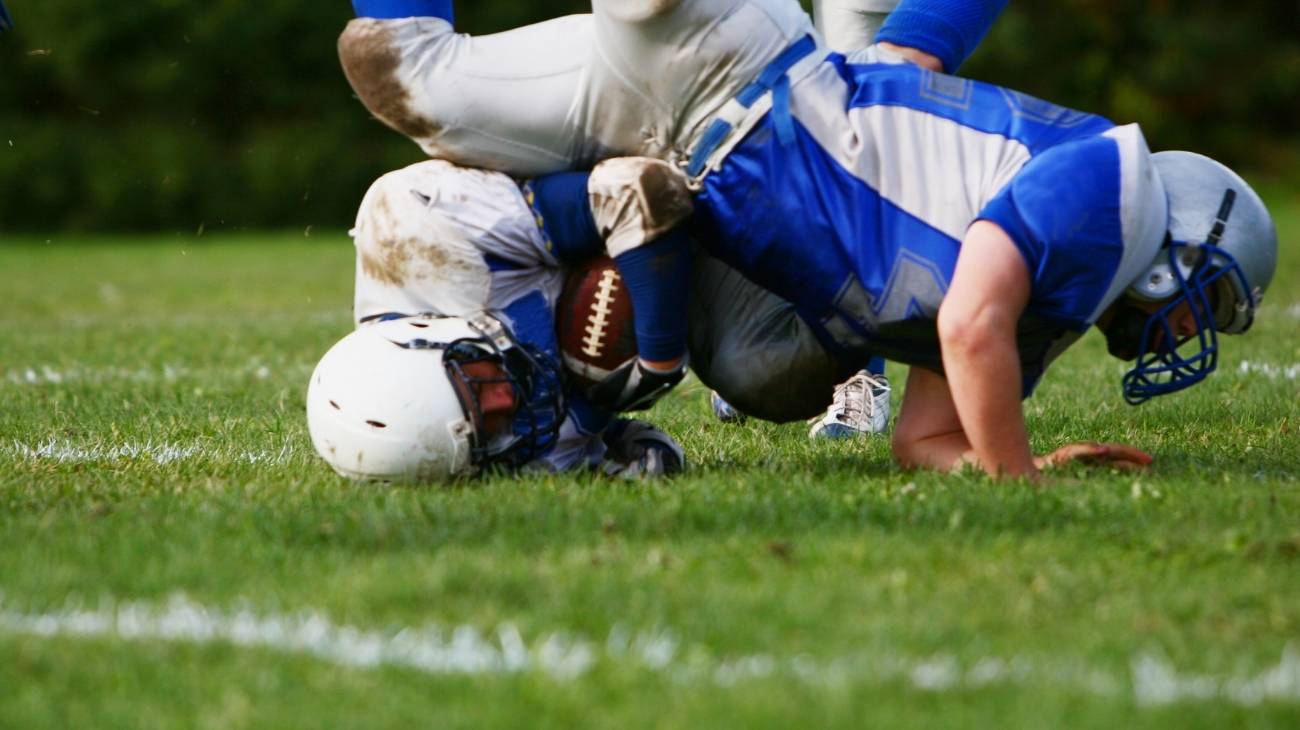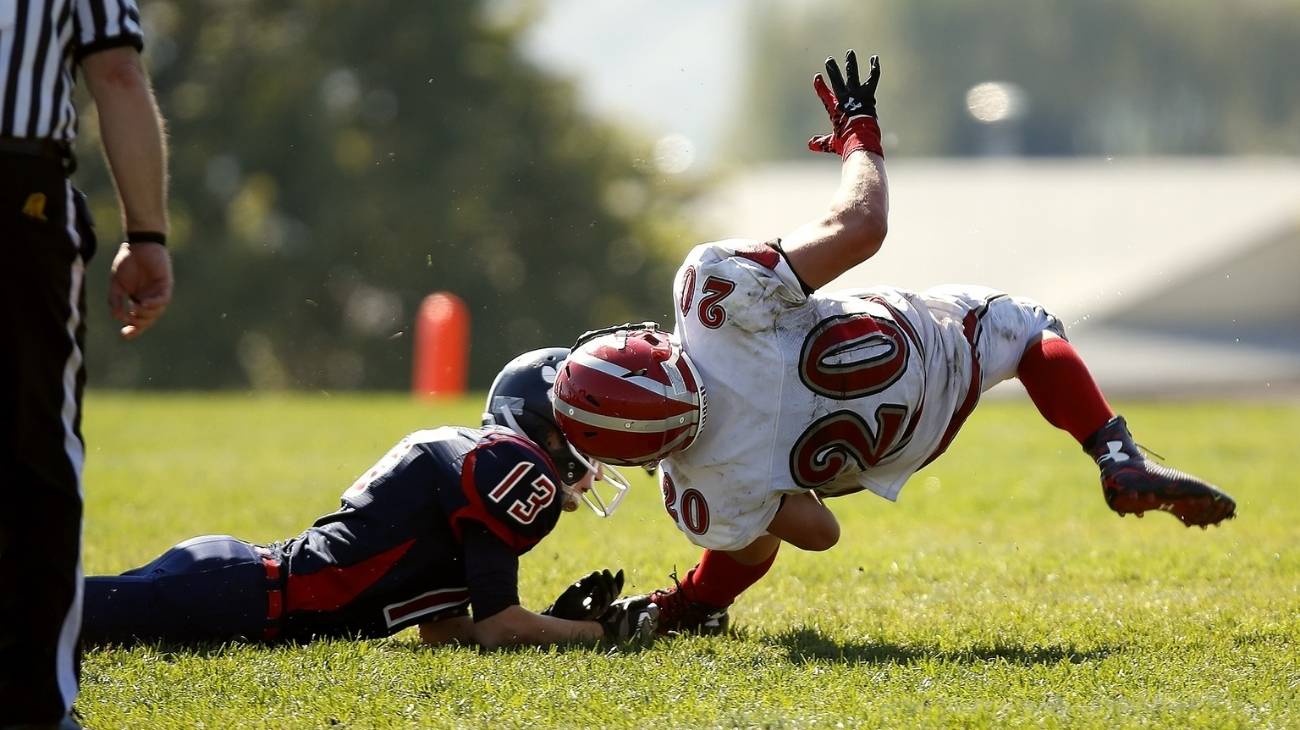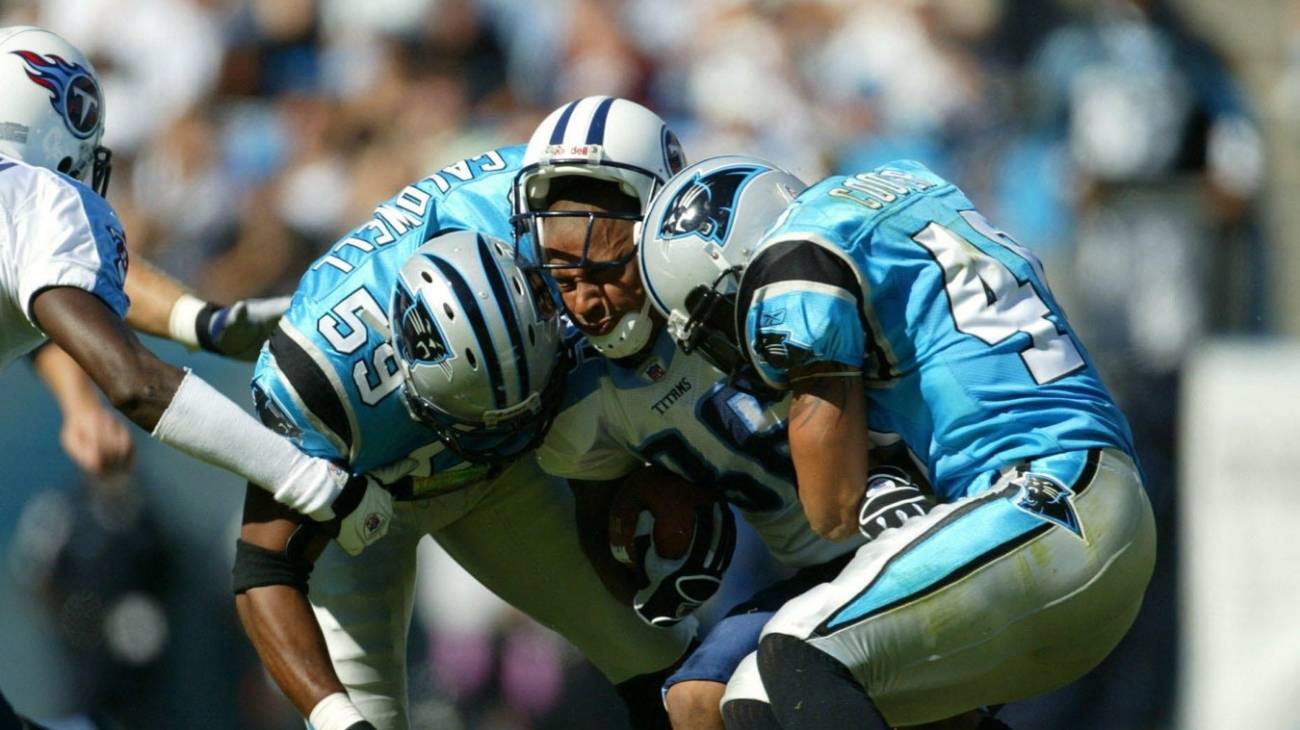Football is one of the sports in which most joint and bone injuries are sustained. In fact, along with rugby, it is the discipline in which 100% of players will suffer at least one injury during the entire season. The figure is reduced for those who play as amateurs, but is still considerably high.
On some occasions, injuries become more complicated and require the application of specific treatments to achieve a speedy recovery. Below you will learn what those treatments are, as well as the most common injuries in the sport and how to apply the PRICE therapy to avoid short-term complications.
What are the most common types of injuries when playing football?
Football is one of the most complex sports at a strategic level, but also one of the most violent, since during a game there are strong clashes between rival players to prevent progress and opposing touchdowns. Among the most common we can identify the following:
- Shoulder dislocation: A strong tackle or a fall after a tackle can cause the upper head of the humerus to move out of its natural position in the scapular cavity. When the movement does not completely separate the two bones, it is known as a subluxation, while when the two bones separate completely, it is called a total dislocation.
- Clavicle fracture: Another injury resulting from a strong tackle that generates a direct impact on this bone, causing it to partially or totally fracture. It is more common in Quarterbacks and Wide Receivers, but basically any player could suffer it.
- Whiplash or cervical sprain: This is damage to muscles and ligaments of the neck that is caused by a sudden transfer of energy that causes the neck to move back and forth or vice versa. While there is a lot of protection in football in this area, wide receivers often suffer from this problem when they are forcefully stopped in their run to receive a pass from the quarterback.
- Knee Bursitis: It consists of the inflammation of the synovial bursa of the joint, which occurs due to the repetitive use of the same without having performed a good warm-up. Both the intense running of the runners and the disputes between offensive and defensive players of both teams can generate this injury.
- Knee sprain: A pronounced sprain that generates excessive extension of the knee ligaments, causing them to tear partially or completely. This generates inflammation accompanied by severe and sharp pain throughout the joint.
- Anterior cruciate ligament rupture: When this ligament is overextended, or when returning to the ground after a jump generates an impact without cushioning, it can rupture completely, causing a lot of pain and basically making the simple act of walking impossible. Runners are usually the most prone to suffer this injury.
- Craniocerebral trauma: An injury caused by a severe blow to the head from either a helmet strike during a tackle, or a hard fall to the ground. It should be carefully evaluated as it could have serious consequences with cerebral edema or permanent damage to the brain.
- Frozen shoulder: A capsulitis that causes numbness in the shoulder and limits its mobility. It can be common in quarterbacks due to excessive use of the joint without a good warm-up, or as a result of a blow received during an opponent's tackle.
Best products for football injury recovery
Bestseller
-
2 Calf Compression Sleeve (Black/Gray)
$19.95 -
2 Calf Compression Sleeve (Green/Navy)
$19.95 -
2 Calf Compression Sleeve (Pink/Bordeaux)
$19.95 -
2 Knee Compression Sleeve (Black/Gray)
$19.95 -
2 Knee Compression Sleeve (Green/Navy)
$19.95 -
2 Knee Compression Sleeve (Pink/Bordeaux)
$19.95 -
2 Thigh Compression Sleeve (Black/Gray)
$19.95 -
2 Thigh Compression Sleeve (Green/Navy)
$19.95 -
2 Thigh Compression Sleeve (Pink/Bordeaux)
$19.95 -
Acupressure Mat and Pillow (Black/Gray)
$49.95 -
Acupressure Mat and Pillow (Green/Navy)
$49.95 -
Acupressure Mat and Pillow (Pink/Bordeaux)
$49.95 -
Acupressure Pillow (Black/Gray)
$29.46 -
Acupressure Pillow (Green/Navy)
$29.46 -
Acupressure Pillow (Pink/Bordeaux)
$29.46 -
Back Support Belt (Black)
$34.95 -
Back Support Belt (Green)
$34.95 -
Back Support Belt (Pink)
$34.95 -
Foot Massage Roller for Plantar Fasciitis (Black)
$19.95 -
Foot Massage Roller for Plantar Fasciitis (Green)
$19.95 -
Foot Massage Roller for Plantar Fasciitis (Pink)
$19.95 -
Gel Eye Mask for Puffy Eyes (Gold/Black)
$11.95 -
Gel Eye Mask for Puffy Eyes (Orange/Pink)
$11.95 -
Gel Eye Mask for Puffy Eyes (Purple/Turquoise)
$11.95 -
High Density Foam Roller for Muscle (Black/Gray)
$29.95 -
High Density Foam Roller for Muscle (Green/Navy)
$29.95 -
High Density Foam Roller for Muscle (Pink/Bordeaux)
$29.95 -
Ice Massage Roller Ball (Black)
$39.95 -
Ice Massage Roller Ball (Green)
$39.95 -
Ice Massage Roller Ball (Pink)
$39.95 -
Microwave Heating Pad for Back Pain Relief (Extra Large) (Hearts)
$29.95 -
Microwave Heating Pad for Back Pain Relief (Extra Large) (Oxford)
$29.95 -
Microwave Heating Pad for Back Pain Relief (Extra Large) (Sport)
$29.95 -
Microwave Heating Pad for Neck & Shoulder Pain Relief (Hearts)
$24.95 -
Microwave Heating Pad for Neck & Shoulder Pain Relief (Oxford)
$24.95 -
Microwave Heating Pad for Neck & Shoulder Pain Relief (Sport)
$24.95 -
Microwave Heating Pad for Neck Pain Relief (Hearts)
$19.95 -
Microwave Heating Pad for Neck Pain Relief (Oxford)
$19.95 -
Microwave Heating Pad for Neck Pain Relief (Sport)
$19.95 -
Pack 2 In 1 Foam Roller High + Soft Density (Black/Gray)
$29.95 -
Pack 2 In 1 Foam Roller High + Soft Density (Green/Navy)
$29.95 -
Pack 2 In 1 Foam Roller High + Soft Density (Pink/Bordeaux)
$29.95 -
Shoulder Support Brace (Black)
$24.95 -
Shoulder Support Brace (Green)
$24.95 -
Shoulder Support Brace (Pink)
$24.95 -
Soft Density Foam Roller for Recovery (Black)
$29.95 -
Soft Density Foam Roller for Recovery (Green)
$29.95 -
Soft Density Foam Roller for Recovery (Pink)
$29.95 -
Trigger Point Massage Stick (Black)
$14.95 -
Trigger Point Massage Stick (Green)
$14.95 -
Trigger Point Massage Stick (Pink)
$14.95
How to apply the RICE therapy to treat first aid injuries in football?
Most soft tissue injuries can be treated with the RICE therapy, which is nothing more than a series of steps designed to alleviate the immediate symptoms after suffering a traumatic injury, especially in the soft tissues.
This method has been updated to PRICE, which is briefly explained in the following steps:
- Protection: It consists of immobilizing the injury to prevent it from receiving a new blow that makes the injury much more serious than it was originally treated.
- Rest: The injured joint or body part should not be moved until the extent of the injury is known, otherwise there is a risk of aggravating the injury.
- Ice: With the application of ice a vasoconstriction is achieved that will reduce tissue inflammation and relieve pain in the short term.
- Compression: A bandage or compressive garment is used to apply pressure on the injury and keep its temperature stable, as well as to minimize the likelihood of the injury becoming inflamed.
- Elevation: This consists of elevating the injured part of the body so that the blood supply is reduced and the injury does not become inflamed again.
Surgical treatments to cure severe or chronic injuries in football players
When injuries cannot be healed by conventional treatments, it is inevitable to go to the operating room to solve the problem that prevents the recovery of the athlete. This not only achieves a complete rehabilitation, but also prevents the injury from becoming a chronic problem that will affect the player's performance for the rest of his life, and in turn affect the quality of his life.
Head and neck injuries
Neck injuries in football players are usually treated with non-invasive methods due to the large number of nerves involved, which considerably increases the risks of surgery. Therefore, this method is rarely used, but the following are among the options available:
- Surgery for cervical disc herniation: the most commonly used strategy is to make an incision in the back of the neck to subsequently remove the herniated disc, and proceed to exchange it with an artificial disc whose purpose is to mimic the function and occupy the space of the original. Another way is to fuse the vertebrae to fill the space left by the affected vertebra, avoiding the insertion of the artificial disc.
- Neck fracture surgery: when one of the cervical discs of the neck is slightly fractured, an open surgery is performed in which the medulla is decompressed and a box containing bone graft is implanted together with a screwed plate.
- Drainage of subdural hematoma: this injury is the result of a strong blow to the head. An incision is made in the skull to proceed to drain the excess fluid that has accumulated while the hematoma was active, and then close the wound. The patient will be at least 5 days under observation to rule out brain damage, and then will be between one and two months of total rest before returning to physical activity.
Shoulder injuries
Shoulder surgeries are much more common in football due to the large number of injuries to this joint each year. Among the most common surgical procedures we can identify the following:
- Shoulder arthroscopy: a small incision or several of them are made to introduce an arthroscope to see inside the joint without having to open it completely, and proceed to repair the damaged tissues. It is a fairly common procedure to treat soft tissue injuries.
- Reconstruction of the rotator cuff: when this muscular assembly is damaged, a reconstruction is performed by exchanging the damaged ligaments for grafts, or suturing the affected tendons. It can be done by arthroscopy, or if the damage is very extensive, by open surgery.}
- Surgery for clavicle fracture: it is a fairly simple procedure in which an incision is made in the area closest to the fracture, and the bone is positioned correctly and fixed with the help of plates, rods or pins, which will be removed once the clavicle is consolidated again. This process is slow and has kept many players out of the season.
Knee injuries
The knee is another of the most injured parts of the body in football. Although surgical intervention is avoided as much as possible, when it is unavoidable, one of the following operations is performed:
- Knee cartilage repair: it is a process by means of which grafts are introduced in the areas of damaged cartilage, so that this one regenerates. The surgery is usually done by arthroscopy to be as minimally invasive as possible, and usually lasts between 2 and 3 hours.
- Anterior cruciate ligament repair: an open surgery is performed to replace the torn or damaged ligament with a graft of the patient's own tissue. This will be fixed with surgical anchors or other fixation instruments, and the wound will be closed. It is a quick surgery but the recovery process can take up to 6 months.
References
- Saal, J. A. (1991). Common American football injuries. Sports medicine, 12, 132-147. https://link.springer.com/article/10.2165/00007256-199112020-00005
- Kelly, B. T., Barnes, R. P., Powell, J. W., & Warren, R. F. (2004). Shoulder injuries to quarterbacks in the national football league. The American journal of sports medicine, 32(2), 328-331. https://journals.sagepub.com/doi/abs/10.1177/0363546503261737
- Pellman, E. J., Viano, D. C., Casson, I. R., Arfken, C., & Powell, J. (2004). Concussion in professional football: Injuries involving 7 or more days out—Part 5. Neurosurgery, 55(5), 1100-1119. https://journals.lww.com/neurosurgery/Abstract/2004/11000/Concussion_in_Professional_Football__Injuries.14.aspx
- Bradley, J. P., Klimkiewicz, J. J., Rytel, M. J., & Powell, J. W. (2002). Anterior cruciate ligament injuries in the National Football League: epidemiology and current treatment trends among team physicians. Arthroscopy: The Journal of Arthroscopic & Related Surgery, 18(5), 502-509. https://www.sciencedirect.com/science/article/abs/pii/S0749806302348588
- Brophy, R. H., Wright, R. W., Powell, J. W., & Matava, M. J. (2010). Injuries to kickers in American football: the National Football League experience. The American journal of sports medicine, 38(6), 1166-1173. https://journals.sagepub.com/doi/abs/10.1177/0363546509357836
- Yang, J., Cheng, G., Zhang, Y., Covassin, T., Heiden, E. O., & Peek-Asa, C. (2014). Influence of symptoms of depression and anxiety on injury hazard among collegiate American football players. Research in sports medicine, 22(2), 147-160. https://www.tandfonline.com/doi/abs/10.1080/15438627.2014.881818
- Luke, A. C., Bergeron, M. F., & Roberts, W. O. (2007). Heat injury prevention practices in high school football. Clinical journal of sport medicine, 17(6), 488-493. https://journals.lww.com/cjsportsmed/Abstract/2007/11000/Heat_Injury_Prevention_Practices_in_High_School.9.aspx
- Gacek, M. (2015). Association between self-efficacy and dietary behaviours of American football players in the Polish Clubs in the light of dietary recommendations for athletes. Roczniki Państwowego Zakładu Higieny, 66(4). https://agro.icm.edu.pl/agro/element/bwmeta1.element.agro-4c51ea03-3e22-45c6-bf0d-3c214d929a81
- Abbey, E. L., Wright, C. J., & Kirkpatrick, C. M. (2017). Nutrition practices and knowledge among NCAA Division III football players. Journal of the International Society of Sports Nutrition, 14(1), 13. https://www.tandfonline.com/doi/full/10.1186/s12970-017-0170-2
- Smart, B. J., Haring, R. S., Asemota, A. O., Scott, J. W., Canner, J. K., Nejim, B. J., ... & Schneider, E. B. (2016). Tackling causes and costs of ED presentation for American football injuries: a population-level study. The American journal of emergency medicine, 34(7), 1198-1204. https://www.sciencedirect.com/science/article/abs/pii/S0735675716001649

